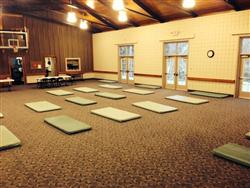By Kelly Hines
In January 2014 Katie Bryant, the Minister of Children & Outreach at St. Timothy’s Episcopal Church, stood before our congregation and told us that our fellowship hall was about to become an overflow homeless shelter for the city of Winston-Salem. After the meeting, I went up to her and simply said, “I don’t know what I can do, but I want to help.”
I have never been particularly called to help the homeless. Those without homes, those standing on street corners asking for money, have always existed outside my periphery. I’d become an expert at avoiding eye contact, dodging questions from my children, and stifling any guilt I had about drinking that $4 latte. So what was it now that made me feel called to action?
I asked myself that same question a couple of weeks later, when I stood next to my teenaged daughter, getting ready to serve dinner to the twenty homeless guests that would be staying with us that night. “I’m nervous,” she said. I didn’t say so, but I felt the same way. Twenty men and women shuffled in after turning in all their worldly possessions at the door. They laid donated blankets and paper thin pillows on worn mats. They made their beds with care, exchanged banter with each other, then made their way to the food.
“Ma’am, that looks so good.”
“God bless you, that looks warm and I am so cold.”
“Thank you for opening your church.”
“Thank you for this meal.”
“Thank you.”
My daughter turned to me and had tears in her eyes. “Oh, mom. They’re just people.”
That’s when I knew what forced me into this uncomfortable place, to do things I’d never done before. Because these are people; human beings in need of help and deserving of love and respect. People who have lost so much of their dignity, and we have the opportunity to give a little of it back through a warm meal and a safe bed and a listening ear. Love is powerful stuff.
So are socks. Imagine, if you can, walking miles every day in the same socks you wore yesterday, and the day before, and the day before. Imagine, if you can, the indignity of being a menstruating woman with very limited options on public restrooms, and nothing to use if you can find one open to you. Imagine, if you can, standing outside in the wind and cold every day and not being able to reach into your pocket and grab a tube of chapstick. These are simple things, but they are luxuries to our homeless friends.
So is real, concrete help. Mental health and addiction services. People trained to navigate the systems to help our guests find jobs and get housed. Treating homelessness is wonderful, but ending it is even better.
On December 1, St. Timothy’s, along with several other area churches, once again opened to serve as overflow shelters for Winston-Salem. They operate in addition to the year round shelters, which simply cannot accommodate everyone who needs someplace warm during the cold winter nights.
Here’s what homelessness looks like in your community:
~ In Guilford County, approximately 897 people (including 174 children) experience homelessness on any given night. The third highest by county rate in the state.
~ In Forsyth County, approximately 515 people (including 64 children) experience homelessness on any given night. The seventh highest by county rate in the state.
Here’s how you can help:
~ In Guilford County, check out Partners Ending Homelessness, a coalition of organization dedicated to ending homelessness.
~ In Forsyth County, check out City With Dwellings, a cooperative which operates Winston-Salem’s winter overflow shelter program.
~ Additionally, you can visit the city government pages to find out what your city is doing to help it’s most vulnerable citizens:
http://www.greensboro-nc.gov/
http://www.cityofws.org/
http://www.high-point.net/
















